
(a)
Solution to (i) and (iii)
- Where this transfer rate will provide the proper motivation, it?s not clear
that it is appropriate for evaluating branch performance. With this rate the
Uganda Bank (E.A) Ltd. receives all the credit for the 7.5% incremental systemwise
contribution associated with lending Kampala Branch deposits at Uganda
Bank Ltd. (i.e. 20% -12.5%), while the Kampala Branch will always show a loss of
slightly less than it?s fixed and other expenses.
- Moreover, given that Uganda Bank Ltd?s only source of funds is the
22%Eurodollars, this incremental contribution is to a large extent attributable to
the Kampala Branch.
- Perhaps a transfer rate equal to the 20% Uganda Bank (EA) Ltd loan rate is
appropriate for evaluating the performance of the Kampala Branch.
- This would however fail to compensate Uganda Banks for the costs associated
with soliciting and serving the loans. Thus the best policy may be to use dual
rates, with the Uganda Bank rate being tied to the Kampala Branch cost of funds
and the Kampala Branch rate being tied to the Uganda (EA) Ltd. rate (This
structure would also provide the appropriate motivation, as transfers would take
place except when the Uganda Bank (Ltd) loan rate dropped below the Kampala
Branch cost of funds or Kampala branch loan rate which ever is higher or when
the Kampala Branch cost of funds rose above the Uganda Bank (EA) Ltd Loan
rate).
- At this point, it is worthy noting that the need for dual rates highlights the fact
that the branches are sufficiently interdependent so as to make evaluation as
individual financial performance centers a questionable practice. Since neither
branch can obtain the 7.5% incremental contribution acting separately, it is
difficult or impossible to evaluate them meaningfully as separate entities.
- Some students may raise the question about whether dual rates may lead to
“Loose” cost of control by both branches. After all, each branch will be
enjoying extremely favourable transfers prices.
b) Given an increase in the Kampala branch loan rate to 14% as well as no significant
increase in Loan demand at this branch the “Outlay cost plus opportunity
cost” rule will seem to profit to retention of the 12.5% transfer rate advocated in (a) as
Mr. Obok still has “excess capacity” (i.e. excess lendable funds) and therefore no
opportunity cost on these funds.
- However, in sight of the loan rate differential between the two branches, total bank
profits will be maximized only if all funds above the reserve requirement are
transferred to Uganda Bank (EA) Ltd. Thus the appropriate transfer rate would be
slightly above 14% because this is the lowest rate at which it is disadvantageous for
Mr. Obok to solicit loans with rates below the Uganda Bank (EA) Ltd rate.
- In other words, the “general rule” in the chapter is interpreted as 12.5% + (14.0
– 12.5%) = 14% on any funds having a valid opportunity cost. (The word solicit
was used because it is necessary to make a limited number of “Loss-
Leader” loans in order to compete for the deposit business.
- If a credit worthy pastor of the retired community requests a loan, it is usually a
competitive necessity that the loan be made.
- In a service, the outlay cost plus opportunity cost rule is still applicable because our
objective is to put Obok in a position where he would not have “excess capacity”
(i.e., where he is servicing something less than the potential Kampala
Branch Loan Demand). Only if the Uganda Bank Loan rate drops below 14%
would we prefer to have Mr. Obok lend his funds at Kampala Branch.
- The use of the 14% rate for evaluation of branch performance raises the
same problems outsourced above, because the total bank profit-maximizing
function of the Kampala Branch is to act as a saw material supplier for
Uganda Bank, if separate evaluation is to be made, the dual rate structure
outsourced above is still appropriate.
c) Assuming a decrease in the Eurodollar rate to 18%, as well as a 12% Loan rate at
Kampala Branch, the 12.5% transfer rate advocated above remains proper from a
motivational point of view.
- Under these circumstances, however it is possible to clearly indicate that
incremental contribution attributable to each branch with a transfer price.
Specifically, if the Kampala Branch had not been built, Uganda Bank would be
making an incremental contribution of 2% (i.e. 20% - 18%). Thus the incremental
contribution of the Kampala Branch is 5.5% (i.e. 18% - 12.5%), and the
appropriate transfer price for evaluation of branches is the 18% Eurodollar rate.
(In general, as long as the Eurodollar rate is below the Uganda Bank rate, a
transfer price tied to the Eurodollar rate will also provide the proper motivation.)
- Mr. Obok will be motivated to solicit and transfer deposits to Uganda Bank so
long as the Eurodollar rate is greater than his loan rate and/or cost of funds).
- It was pointed out in the above discussion on the transfer rate appropriate for
evaluating branches that the branches are sufficiently interdependent so as to
make individual evaluation by an income statement based on transfer prices of
limited value.
- The same conclusion applies to management evaluation. A related problem is the
fact that the income figure may fluctuate for seasons unrelated to the
performance of the individual manager.
- For example, assume that we had decided to use the dual rate (i.e. 20% for Mr.
Obok and 12.5% for Mr. Kamau) advocated above and that after the decline in
the Eurodollar rate in (c) it was decided to use 18% for evaluation. The resulting
2% decline in Mr.Obok?s contribution is no way related to his
performance or toany decision variables under his control.
- This type of fluctuation could probably be avoided by using the dual rate structure
for management evaluation. However, even the approach is less than acceptable
to the extent that Mr. Kamau?s performance is dependant on the rate Mr.
Obok has to pay on savings deposits while Mr. Obok?s performance is
dependent on the prevailing Uganda Bank (EA) Ltd. Loan rate, variables over
which neither of them really has control.
- If income statements are to be used for evaluating managers, they should
probably be based on dual rates combined with measures of variable more closely
connected with managerial performance such as deposit and loan market share
and cost control performance.
Kavungya answered the question on May 8, 2021 at 11:49
-
Siku Kuu Ltd. Manufactures and distributes a line of Christmas gifts. The company had
neglected to keep its gifts line current. As a result, sales have...
(Solved)
Siku Kuu Ltd. Manufactures and distributes a line of Christmas gifts. The company had
neglected to keep its gifts line current. As a result, sales have decreased to approximately 25,000
units per year fro a previous high of 125,000 units. The gifts have been redesigned recently and
is considered by company officials to be comparable to its competitors‟ models.
The company plans to redesign the gifts each year in order to compete effectively. Kama
Kawaida, the Sales Manager, is not sure how many units can be sold next year, but she is willing
to place probabilities on her estimates. Kama Kawaida's estimates of the number of
units that can be sold during the next year and the related probabilities are as follows:
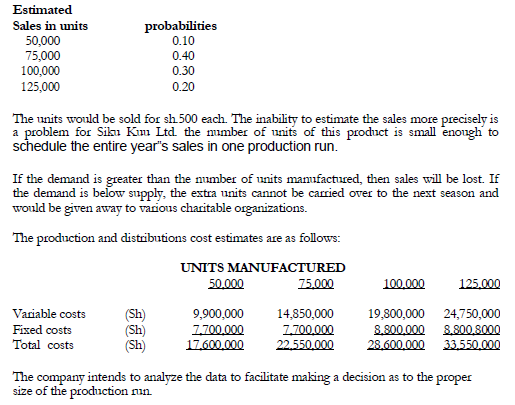
Required:
a) Prepare a payoff table for the different sizes of production runs required to meet the four
sales estimates prepared by Kama Kawaida for Siku Kuu Ltd.
If Siku Kuu Ltd. relied solely on the expected monetary value approach to make
decisions, what size of production run would be selected?
b) Identify the seven basic steps that are taken in any decision process. Explain each step by
reference to the situation presented by Siku Kuu Ltd. and your answer to requirement (a)
Date posted:
May 8, 2021
.
Answers (1)
-
A company makes a lotion that is manufactured through two processes, A and B. on the 1 November 1995, work in process consisted of the...
(Solved)
A company makes a lotion that is manufactured through two processes, A and B. on the 1 November 1995, work in process consisted of the following:
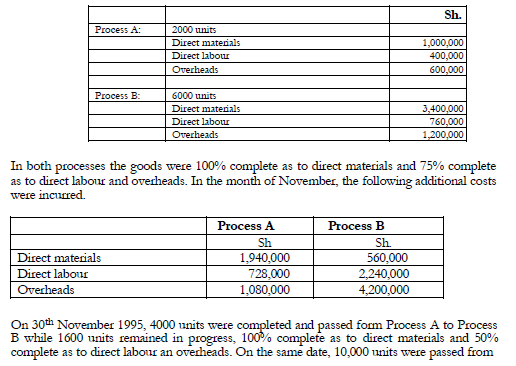
Process B into finished goods while 4000 units remained in progress, 100% complete as to
direct materials and 50% complete as to direct labour and overheads.
All inventories are valued on the weighted average cost basis and transfers from process A
to Process B are treated as part of direct material cost.
Required:
The cost accounts for both processes for the month of November 1995.
Show all supporting computations including the inventory flow through each process.
Date posted:
May 8, 2021
.
Answers (1)
-
The Finance Director of Africa Problems Ltd. is considering developing a flexible-budget
formula for the manufacturing overhead costs.
The accounting staffs have suggested that simple linear regression...
(Solved)
The Finance Director of Africa Problems Ltd. is considering developing a flexible-budget
formula for the manufacturing overhead costs.
The accounting staffs have suggested that simple linear regression be used to determine the
cost behaviour pattern of the overhead cost. They consider that this method would provide
a good and quick estimate of the costs that can be expected to be incurred each month. The
actual direct-labour hours and corresponding manufacturing overhead costs for each month
between 1996 and 1999 were used in the linear-regression analysis.
The following occurrences during the period are considered unusual:
1. Production was reduced in one month during 1997 due to wildcat strikes related to
political changes in one of the countries.
2. In 1998, production was reduced in one month because of material shortages and
materially increased (overtime scheduled) during two-months to meet the units
required for one-time sales order.
3. Employee benefits were raised significantly in December 1998 as a result of a labour
agreement.
4. Production during 1999 was not affected by any special circumstances.
The accounting staff raised the following issues:
Some members question whether historical data should be used at all to form the basis
for a flexible-budget formula.
Some members believe that he use of data from all 48 months would provide a more
accurate portrayal of the cost behaviour. While they recognized that any of the monthly
data could include efficiencies, they believed these would tend to balance out over a
long period of time.
Still other members felt that only the most recent 12 months should be used because
they were the most current.
Other members of the accounting staff suggested that only those months that were
considered normal should be used so that the regression would not be distorted.
The accounting department ran two regression analyses of the data, one using the data from
all 48 months and the other using only the data from the last 12 months.
The results were as follows:
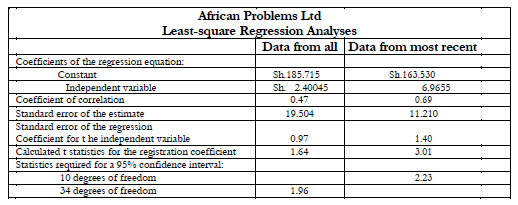
a)
i Formulate the flexible-budget equation that can be employed to estimate monthly
manufacturing-overhead costs.
ii Calculate the estimate of overhead costs for a month when 37.500 direct labour
hours are worked.
b) Using only the results of the two regression analysis above, explain which of the two
results is more appropriate as a basis for the flexible-budget formula.
c) Evaluate and explain how each of the four issues raised by the accounting department
staff influence our willingness to use the results of the statistical analyses as the basis for
the flexible-budget formula.
Date posted:
May 8, 2021
.
Answers (1)
-
Samaki Ltd., a company based in Mombasa, exports vital fishing hooks to Madagascar.
The demand for the hooks is constant and Samaki Ltd., is able to...
(Solved)
Samaki Ltd., a company based in Mombasa, exports vital fishing hooks to Madagascar.
The demand for the hooks is constant and Samaki Ltd., is able to predict the annual
demand with considerable accuracy. The predicted demand for the next couple of year is
200,000 hooks per year.
Samaki Ltd. purchases its hooks from a manufacturer in Mombasa at a price of Sh.400
per hook. In order to transport the purchases from Mombasa to Madagascar, Samaki Ltd.
must charter a ship. The charter services usually charge Sh.20,000 per trip plus Sh.40 per
hook (this includes the cost of loading the ship). The ships have a capacity of 10,000
hooks. The placing of each order including arranging for the ship requires 5 h ours of
employee time. It takes about a week for an order to arrive at the Samaki Ltd. warehouse
in Madagascar. The warehouse has a capacity of 15,000 hooks.
When a ship arrives at the Samaki warehouse, the hooks can be unloaded at a rate of 25
hooks per hour per employee. The unloading equipment used by each employee is rented
from a local supplier at a rate equivalent to Sh.100 per hour. Supervisory time for each
shipload is about 4 hours. The employees working in the warehouse have several tasks:
i Placing the hooks into storage, after they are unloaded which can be done at the
rate of about 40 per hour.
ii Checking, cleaning etc. of the hooks in inventory requires about one-half hour
per hook per year.
iii Removing a hook from inventory and preparing it for shipments to a customer
requires about one-eighth of an hour.
iv Security guards general maintenance, etc. require about 10,000 hours per year.
The average cost per hour of labour is equivalent to Sh.200 (including fringe benefits).
Samaki Ltd. has developed the following prediction equation for its general overhead
(excluding shipping materials, fringe benefits, and equipment rental):
Predicted overhead for the year = Sh.20,000,000 + (Sh.160 x Total labour hours)
The materials used to ship one hook to a customer costs Sh.20 and the delivery costs
average out to about Sh.40 per hook.
The company requires a before-tax rate of return of 20 per cent on its investment.
The ordering policy from the manufacturers by Samaki Ltd., is based on an EOQ. Model,
which is determined by the demand for hooks in Madagascar.
Required
a) Determine the quantity that should be ordered each time and the re-order level
b) If the true overhead prediction equation is:
Sh.16,000,000 + (Sh.240 x Total labour hours), what is the cost of the prediction error?
Date posted:
May 8, 2021
.
Answers (1)
-
Mwito Club is a charitable organization based in Nairobi. For the last 20 years, the
club has held an annual dinner and dance event with the...
(Solved)
Mwito Club is a charitable organization based in Nairobi. For the last 20 years, the
club has held an annual dinner and dance event with the primary aim of raising
funds to help the less fortune members of the society.
This year, there is concern that an economic recession may adversely affect the
success of the event with a fall in the number of guests attending and sale of
advertising space in the published events programme.
A study of past experience, current prices and quotations shows that the following
costs and revenues will apply for the event:
Revenue
Dinner and dance
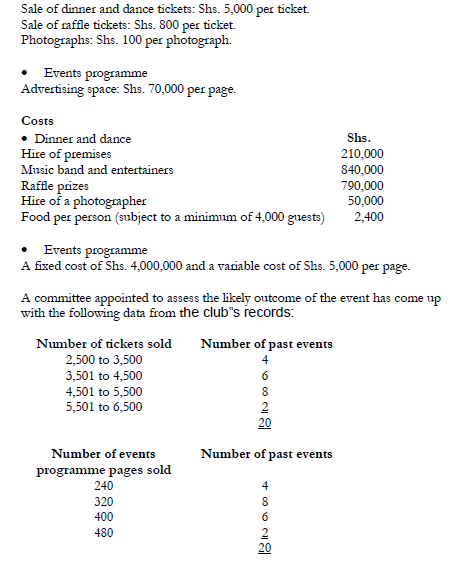
Required:
(i) The expected profit from the event. (Assume one raffle ticket and one
photograph per attendant).
(ii) Describe how cost-volume-profit (C-V-P) analysis can be applied in
absorption costing.
Date posted:
May 7, 2021
.
Answers (1)
-
Angels of Mercy Mission Hospital operates on charity basis. The hospital?s board
of directors has recently complained about the increasing size of the cost budget insisting...
(Solved)
Angels of Mercy Mission Hospital operates on charity basis. The hospital‟s board
of directors has recently complained about the increasing size of the cost budget insisting that
the management should cut down on costs.
The major concern of the board is the cost of maintaining patients at the intensive care unit
(ICU).
The following information is available on the operations of the hospital:
1. The average cost of maintaining a patient at the ICU per week is Shs. 200,000 compared
to Shs. 100,000 per week incurred in maintaining a patient at the high dependency unit
(HDU) and Shs. 50,000 per week of maintaining a patient at the general ward (GW).
2. Past information on patients indicates that:
(i) 50% of the patients in ICU at the beginning of the week will remain in ICU
at the end of the week and 50% will be transferred to HDU by the end of the
week.
(ii) 10% of the patients in HDU at the beginning of the week will be transferred
to ICU, 50% will remain in HDU, and 40% will be transferred to GW.
(iii) 85% of the patients in the GW at the beginning of the week will remain in
GW at the end of the week, 10% will be transferred to HDU and 5% to ICU.
3. The board of directors believe that the criteria for maintaining patients in the ICU is too
strict and should be relaxed so that only 40% of the patients in ICU at the beginning of
the week remain there at the end of the week while 60% are transferred to HDU.
4. The staff at the hospital insist that if the proposed criterion is adopted:
(i) 20% of patients in HDU at the beginning of the week will be transferred to
ICU, 50% will remain in HDU while only 30% will be transferred to GW.
(ii) No changes will be expected in the GW.
5. Past hospital records indicate that the hospital serves an average of 4,000 patients
weekly.
Required:
(a) The steady state weekly costs under the current policy.
(b) The steady state weekly costs under the proposed policy.
(c) Advise the board on the best policy.
(d) State the assumptions of the quantitative technique used in solving problems (a) and
(b) above.
Date posted:
May 7, 2021
.
Answers (1)
-
Pwani Marine Ltd., a boat construction company, has developed a new type
of speed boat called “Speed Surf.”
The following information has been availed to you:
1. Boat...
(Solved)
Pwani Marine Ltd., a boat construction company, has developed a new type
of speed boat called “Speed Surf.”
The following information has been availed to you:
1. Boat construction is a continuous assembling process carried out at
the company‟s yard.
2. Boat assembling is labour intensive involving the use of two classes of
labour namely:
Skilled labour at a standard rate of Shs. 1,250 per hour.
Semi-skilled labour at a standard rate of Shs. 950 per hour.
3. Experience on boat construction from other models indicates that the use of
skilled labour is associated with an 80% learning curve effect whereas use of
semi-skilled labour is associated with a 90% learning curve effect.
4. Labour usage for the first speed boat assembled was as follows:
Skilled labour – 952 hours.
Semi-skilled labour – 650 hours.
5. In October 2005, the sixth and the seventh speed boats were assembled
from start to finish. During the month, the following labour usage and costs
were recorded:
Skilled labour – 680 hours at a total cost of Shs. 800,400.
Semi-skilled labour – 1,256 hours at a total cost of Shs. 1,281,200.
The management of Pwani Marine Ltd. is concerned about the cost variances and
would like to learn more on the composition of the variances.
Required:
(i) Calculate the standard labour cost of the month of October 2005.
(ii) Reconcile the standard cost with the actual cost for the month of October
2005 showing the labour rate and labour efficiency variances.
(iii) Express the labour efficiency variance in terms of labour mix and labour
output variances. (Value the labour mix variances using standard rates).
Date posted:
May 7, 2021
.
Answers (1)
-
Explain the applications of the learning curve.
(Solved)
Explain the applications of the learning curve.
Date posted:
May 7, 2021
.
Answers (1)
-
Kutwa Ltd. is a manufacturing company with two divisions; A and B. Division A
manufactures a single standard product K, some of which is sold externally...
(Solved)
Kutwa Ltd. is a manufacturing company with two divisions; A and B. Division A
manufactures a single standard product K, some of which is sold externally and the
remainder used as an input in division B in the manufacture of product M.
The unit production costs of product K are given below:
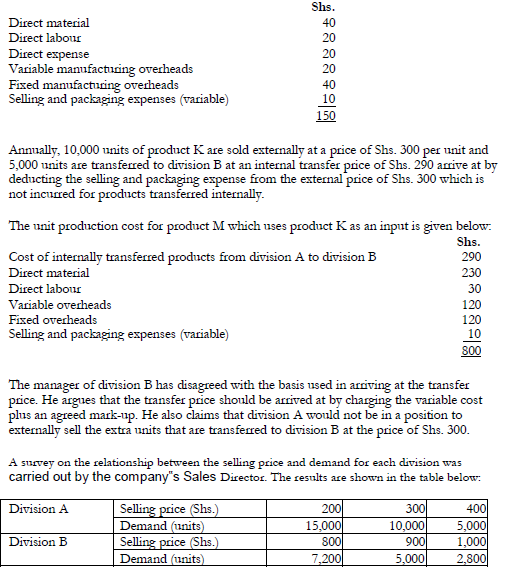
The manager of division B suggests that based on the above results, a transfer price of Shs.
120 would offer division A a reasonable contribution towards its fixed cost and earn
division B a reasonable profit. This would lead to an increase in the output and overall
profitability of the company.
Required:
( a) Calculate the effect of the existing transfer pricing system on the company‟s profits.
( b) Calculate the effect of adopting the transfer price of Shs. 120 on the company‟s
profits.
Date posted:
May 7, 2021
.
Answers (1)
-
Nairobi Manufacturers Ltd. produces component X on machine Y at a rate of 4,000
units per month. Machine Z uses component X at the rate of...
(Solved)
Nairobi Manufacturers Ltd. produces component X on machine Y at a rate of 4,000
units per month. Machine Z uses component X at the rate of 1,000 units per month,
the remainder being put into stock. It costs Shs. 2,000 to set up machine Y while the
stock holding cost is estimated at Shs. 2.50 per unit per annum plus a 20% opportunity
cost of capital per annum. Each component costs Shs. 25 to produce.
Required:
(i) Compute the optimal batch size that should be produced using machine Y.
(ii) Assume that the actual set-up cost of machine Y is Shs. 1,000 instead of
Shs. 2,000. Calculate the cost of prediction error.
Date posted:
May 7, 2021
.
Answers (1)
-
Manukato Ltd. produces a designer perfume called “Hint of Elegance.”
Production of the perfume involves the use of two ingredients, X1 and X2
represented by the production...
(Solved)
Manukato Ltd. produces a designer perfume called “Hint of Elegance.”
Production of the perfume involves the use of two ingredients, X1 and X2
represented by the production function given below:
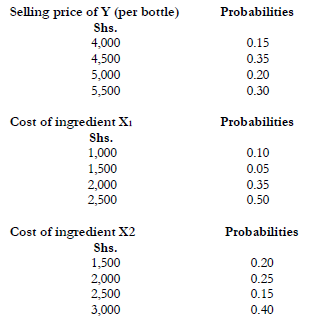
Required:
(i) Calculate the daily expected profit of the company.
(ii) Simulate the company‟s profit for 10 days using the following
random numbers:
58, 71, 96, 30, 24, 18, 46, 23, 34, 27, 85, 13, 99, 24, 44, 49,
18, 09, 79, 49, 74, 16, 32, 23, 02, 56, 88, 87, 59, 41, 06
Date posted:
May 7, 2021
.
Answers (1)
-
Shadow prices may be used in the setting of transfer prices between divisions in a
company, where the intermediate products being transferred are in short supply.
Required:
Explain...
(Solved)
Shadow prices may be used in the setting of transfer prices between divisions in a
company, where the intermediate products being transferred are in short supply.
Required:
Explain why the transfer prices thus calculated are more likely to be favoured by the
management of the divisions supplying the intermediate products rather than the
management of the divisions receiving the intermediate products.
Date posted:
May 7, 2021
.
Answers (1)
-
Transfer pricing of products between processes in a manufacturing company can be done at:
1. Cost or
2. Sales value at the point of transfer.
Required:
Discuss how each...
(Solved)
Transfer pricing of products between processes in a manufacturing company can be done at:
1. Cost or
2. Sales value at the point of transfer.
Required:
Discuss how each of the above methods could be used effectively in the operations
of a responsibility accounting system.
Date posted:
May 7, 2021
.
Answers (1)
-
State four objectives of a transfer pricing system.
(Solved)
State four objectives of a transfer pricing system.
Date posted:
May 7, 2021
.
Answers (1)
-
State the limitations of the use of fame theory in decision making.
(Solved)
State the limitations of the use of fame theory in decision making.
Date posted:
May 7, 2021
.
Answers (1)
-
Topcom Kenya International Limited (TKIL) is a telecommunications company
situated in Nakuru. Recently, the company was faced with a workers strike which
necessitated a renegotiation of the...
(Solved)
Topcom Kenya International Limited (TKIL) is a telecommunications company
situated in Nakuru. Recently, the company was faced with a workers strike which
necessitated a renegotiation of the workers‟ salaries through their union.
The management with the help of a consultant, has prepared the pay-off matrix
shown below:

A positive sign represents a wage increase while a negative sign represents a wage decrease.
Required:
(i) Advise the management on the best strategies.
(ii) The value of the game
Date posted:
May 7, 2021
.
Answers (1)
-
Makazi Ltd. manufactures a hedge-trimming tool which has been selling at Shs.
1,600 per unit for a number of years. The selling price is to be...
(Solved)
Makazi Ltd. manufactures a hedge-trimming tool which has been selling at Shs.
1,600 per unit for a number of years. The selling price is to be reviewed and the
following information is available on costs and the likely demand:
1. The standard variable cost of manufacturing the tool is Shs. 1,000 per unit and
an analysis of the cost variances in the past 20 months shows the following
pattern which the production manager expects to continue in the future.
Adverse variances of 10% of the standard variables cost occurred in ten
of the twenty months.
Nil variances occurred in six of the twenty months.
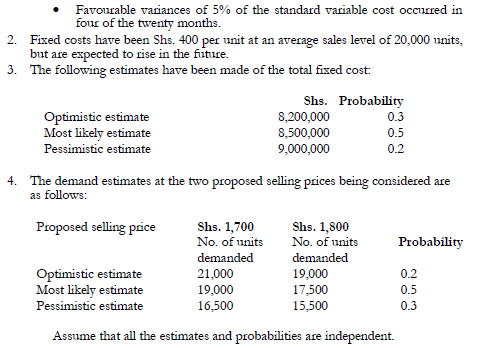
Required:
(i) Based on the information given above, advise the management of Makazi Ltd.
on whether they should change the selling price. Indicate the price you would
recommend.
(ii) The expected profit at the price you have recommended in (i) above and the
resulting margin of safety expressed as a percentage of expected sales
(iii) Comment on the method of analysis you have used to deal with the
probabilities given in the question.
(iv) Explain briefly how the use of a computer program would improve your
analysis.
Date posted:
May 7, 2021
.
Answers (1)
-
Equi -solutions Ltd. was formed ten years ago to provide business equipment solutions tolocal business. It has separate divisions for research, marketing, product design, technologyand...
(Solved)
Equi -solutions Ltd. was formed ten years ago to provide business equipment solutions to
local business. It has separate divisions for research, marketing, product design, technology
and communication services, and now manufactures and supplies a wide range of business
equipment. To date the company has evaluated its performance using monthly financial
reports that analyze profitability by type of equipment. The managing director of Equi solutions
Ltd. has recently returned from a course in which it has been suggested that the
“Balanced Scorecard” could be a useful way of measuring performance.
Required:
a) Explain the “Balanced Scorecard” and how it could be used by Equi-solutions Ltd. to
measure its performance.
b) The managing director of Equi-solutions Ltd. also overheard someone mention how the
performance of their company had improved after they introduced “Bench marking.”
Required:
Explain “Bench-marking” and how it could be used to improve the performance of
Equi -solutions Ltd.
Date posted:
May 7, 2021
.
Answers (1)
-
Best Sell Ltd. has decided to launch a new product in addition to its range of
products. The following information is available:
1. The new product may...
(Solved)
Best Sell Ltd. has decided to launch a new product in addition to its range of
products. The following information is available:
1. The new product may be distributed through any combination of the two
company warehouses W1 and W2.
2. The available monthly production capabilities for the new products are:
1000 units at plant A
2000 units at plant B
1000 units at plant C
3. Three major concentration points of customer demand are at locations E, F
and G which are estimated to have a monthly demand of:
900 units at E
800 units at F
900 units at G
4. The unit production costs amount to Sh.30, Sh.40, Sh.10 at A, B and C
respectively.
5. The unit handling costs at the warehouses amount to Sh.20 and Sh.30 at W1
and W2.
6. The unit transportation costs from plant to warehouse and unit delivery cost
from warehouse to customers are as shown below:
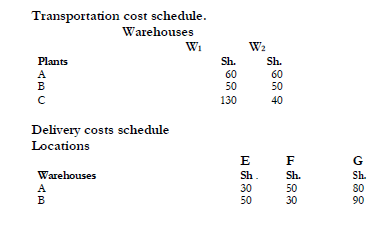
Required:
Determine the optimum production and distribution schedule to minimize total cost.
Date posted:
May 7, 2021
.
Answers (1)
-
Explain the following terms as applied in competitive situations:
i) Degeneracy
ii) Pure strategy
iii) Mixed strategy
iv) Dominance rule
(Solved)
Explain the following terms as applied in competitive situations:
i) Degeneracy
ii) Pure strategy
iii) Mixed strategy
iv) Dominance rule
Date posted:
May 7, 2021
.
Answers (1)